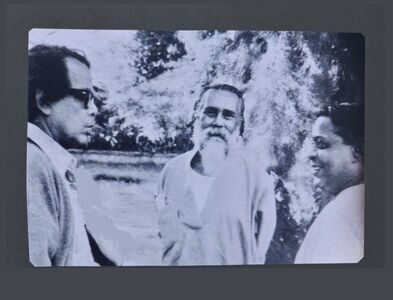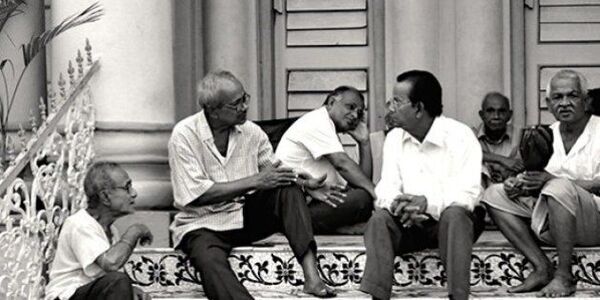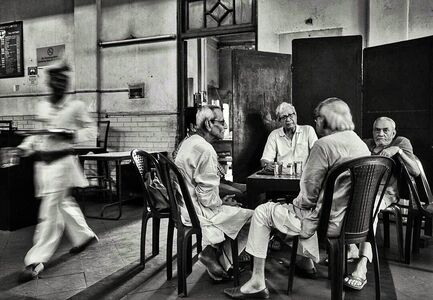
I presented the majestic Adda sessions held at my ancestral home in Taltala presided by my father Nirmal Chandra Kumar, the antiquarian. My father, Nirmal Chandra Kumar, who died of cerebral stroke in 1978, aged 60, was a man who was an antiquarian and owned a rare bookshop. He was also among the greatest influences on a generation of artists, from filmmaker to fiction writers, folk musician to folk artist; actors to activists, writer to wanderer; teachers to travellers ,more so perhaps than any art critic or editor of his times.
For 30 years, he presided over his own collection of rare books, prints, maps, manuscripts and other materials in his establishment opposite a Protestant Church, in a place near Entally, in Calcutta. The bookshop from its opening in 1945, until the death of Kumar in 1978 was Calcutta’s pre-eminent rare bookstore. Whether you wanted books on art, travel, ornithology, botany, history, literature, mountaineering, mutiny, religion; Kumars was the place. Under Kumar’s care, it’s Art and Indology section was its greatest strength, and the tradition of bohemian bookselling was carried forward into the 1950s and 1960s.
It was an untimely death, he was 60. His departure marked the formal end of something that goes beyond the loss that will be faced by family and friends or in the world of academia. Nirmal Chandra was one of the few remaining stalwarts who presided over Adda.

The Calcutta Adda is not just about a few like-minded people gathering together to shoot the breeze as they do in some parts of the world. In its highest form Adda is erudite people getting together to share their knowledge and increase their understanding in an informal, non-structured setting. Often it centred on a book or an engraving but it was never merely a meeting restricted to the contents of the book. Or so it used to be.
What a world it recreated. Film makers like : Satyajit Ray, Mrinal Sen, Shanti Chowdhury. Writers like Kamal Majumdar. Anglophile and Columnist like: Radha Prasad Gupta, popularly known as Shatul, Editors like N J Nanpooria . Actors like: Vasant Chowdhury. Travellers like: Ella Maillart, Peter Fleming. Painters like: Shubho Tagore, Paritosh Sen. Collectors like: Nina Thapar. Historians like Romilla Thapar. Professors like Dhurjati Prasad Mukherjee and Kiran Shankar Mukherjee. Art historians like : Mulk Raj Anand. Journalists like Lindsay Emerson and causal visitors like Nirmalendu Chowdhury, Raghubir Singh, Ashok Mitra, the best and the brightest of Bengal argued, explained, opined, even poked gentle fun at icons like Rabindranath Tagore.
The cine scene in Calcutta, books published, painting exhibition figured prominently in their discussions, as did literature and politics, art and aesthetics, religion and national character, even cricket and the behaviour of animals and insects. Fervent poets clashed with inflexible poem-baiters, Gandhi was reviled by some, worshiped by others, tempers flared, sharp words exchanged, but nothing turned into unseemly brawls or even un-gentlemanly behaviour. Rather, there was much laughter, an eagerness to be back for the next meeting and the next.
Once, while ‘knighthood’ was being discussed, someone said the best person to ask is Nirad Chaudhuri, “he has all this information at his sword tip”. Ironically, Nirad Babu rubbished such addas in his renowned book The Autobiography of an Unknown Indian, as symptomatic of a deep and continuing malaise in the Bengali psyche. “In sharp contrast to the demonic energy shown in rushing to the rendezvous, the languor of the actual proceedings was startling,” he ridiculed.
But even he admitted that perhaps this was “the only disinterested thing in Calcutta society.” Because that is what it was – wholly unselfish, conducted not for any material gain or even with any grand objective in mind. The magazine was incidental, the talk was foremost. That is what lubricated the creative juices of this city, made its dingy, smoke-filled coffee houses and tea shops so vibrant, enriched its language and earned for itself the reputation of being the nation’s cultural hub.
Nirmal Chandra Kumar tried to keep the spirit of the earlier Addas alive till the last days of life. A keen enthusiast he organised endless cups of tea with savouries and food fit for kings. He was a gourmet and placed items which became subjects of discussion. That the common item of ‘Shukto’, served first in a Bengali lunch is adapted from Portuguese became a much debated topic.
Whenever there was an adult discussion I was asked to get some tea or water from the kitchen. I came to know of this and hid to listen to their conversation. Eavesdropped on Shatul Kaku, Paritosh Sen and my father discussing the erotic Art Collection of Sir Ashutosh which Shyama Prasad donated to the National Library with the rider that it is to be kept confidential. Shatul Kaku trailed with the comment: “With the fear that everybody would have exclaimed: “The Royal Bengal Tiger too”.
Bankshi Chandragupta and Mrinal Sen discussing sets, with Satyajit Ray getting worked up. And if you wander into library you could have seen Radha Prasad Gupta pulling the leg of Satyajit Ray with the comment: “Longman how long do we have to wait for Shatranj ki Khilari”.
The word Adda ,pronounced AHD-da, is "a place" for "careless talk with boon companions," as the scholar Sunitikumar Chattopadhyay puts it, and sometimes as "the chat of intimate friends." Another scholar, Vipesh Chakrabarty, writes, "Roughly speaking, it is the practice of friends getting together for long, informal and unrigorous conversations."
Adda is something typically Bengali. It is something very spontaneous. The club life that the upper class have, is not adda. It cannot be 50 people together, that becomes a meeting. So it should be three persons minimum, because if you have two that also is not an Adda.
Adda today is a matter of academic discourse, finding pride of place in weighty essays on ‘Post-colonial Thought and Historical Difference’. It is a selling point for art fairs and lit fests and tea festivals and TV shows – where “organised” Addas, a contradiction in terms, are conducted, often anchored by some celeb or other, a formal get-together of random strangers with little in common, making free-flowing conversation an impossibility.
I presented the anthropological side. The noted French Anthropologist, Lévi-Strauss noted that myths, rituals, and habits in many cultures emphasize dichotomous (two-sided) contrasts. In every society, culturally unique ways of thinking about the world unite people in their behaviour. Anthropologists often refer to the body of ideas that people share as ideology. Ideology can be broken down into at least three specific categories: beliefs, values, and ideals. People’s beliefs give them an understanding of how the world works and how they should respond to the actions of others and their environments. Particular beliefs often tie in closely with the daily concerns of domestic life, such as making a living, health and sickness, happiness and sadness, interpersonal relationships, and death. People’s values tell them the differences between right and wrong or good and bad. Discussions serve as models for what people hope to achieve in life.
To me, the common theme running through these aspects of culture, that is Adda, is not accidental but the result of a fundamental system of logic, common to all people.
Although many Kolkatans boast of the city being the birthplace of Adda culture, Satyajit Ray in his film Agantuk traces back the origin of the tradition to regular intellectual dialogues prevalent in Ancient Greece at the time of Socrates. In our discussion, I decided to turn to one of the oldest methodologies known to the sciences, the “Socratic debate”: the classical form of inquiry between individuals with opposing viewpoints, which is based on asking and answering questions. This is a dialectical method of oppositional viewpoints. A participant may try to trick one’s opponent to contradict himself so as to reinforce one’s own viewpoint at the other’s expense. In this way, Socrates left his victims ridiculed and ashamed. The motive for employing the Socratic debate form, however, is somewhat different from Adda. Instead of seeking to arrive at unambiguous answers through confrontation, the participants use the method primarily to question the models of anthropology that they both hold in an attempt to go beyond the truisms each of them take for granted. The goal, therefore, is not really for one to win the argument, but rather to mutually encourage critical faculties, thereby elucidating new directions for theory.
I can see the contours of Adda, as an attempt to establish a kind of synthesis between exchange-based theories and values-as-worldviews by looking at how action is informed by values and simultaneously creates value. Michael Lambek’s paper for example, is part of this synthetic line of thinking. He aims to expand the Marxist understanding of communication as the source of exchange-value toward a more general theory of value that considers any form of human action from the perspective of value creation. In my view, this rethinking of the connection between communication and value provides the most promising direction for developing a contemporary anthropological theory of Adda.
Adda was incorporated into the Oxford English Dictionary in 2004.The Indian adda has shades of meaning attached to different languages: In Hindi, adda is a noun, with the nominal form of the word meaning the location or nest of a group or community, usually shady people. Somewhat close to ‘Dara’. The etymology can be traced to the original meaning of the word, which means the "perching spot or perch for birds".
Adda may have parallels with the French salon culture at the turn of the 20th century. A salon is a gathering of people under the roof of an inspiring host, held partly to amuse one another and partly to refine the taste and increase the knowledge of the participants through conversation. Salons, commonly associated with French literary and philosophical movements of the 17th and 18th centuries, were carried on until as recently as the 1940s in urban settings. The salons have been studied in depth by a mixture of feminist, Marxist, cultural, social and intellectual historians.



